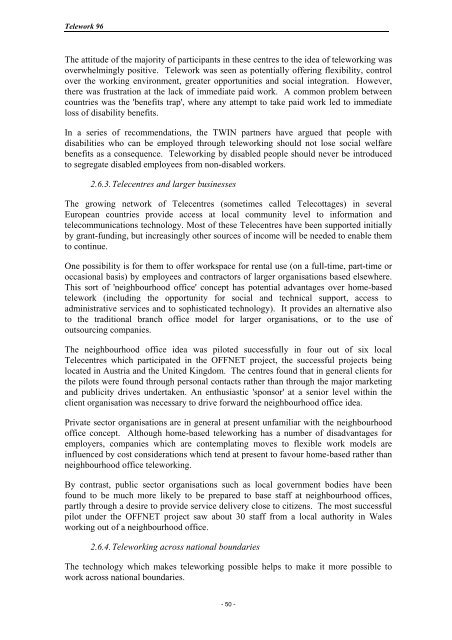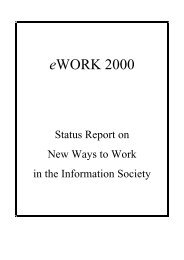1996 - European Telework Week
1996 - European Telework Week
1996 - European Telework Week
- No tags were found...
Create successful ePaper yourself
Turn your PDF publications into a flip-book with our unique Google optimized e-Paper software.
<strong>Telework</strong> 96<br />
The attitude of the majority of participants in these centres to the idea of teleworking was<br />
overwhelmingly positive. <strong>Telework</strong> was seen as potentially offering flexibility, control<br />
over the working environment, greater opportunities and social integration. However,<br />
there was frustration at the lack of immediate paid work. A common problem between<br />
countries was the 'benefits trap', where any attempt to take paid work led to immediate<br />
loss of disability benefits.<br />
In a series of recommendations, the TWIN partners have argued that people with<br />
disabilities who can be employed through teleworking should not lose social welfare<br />
benefits as a consequence. <strong>Telework</strong>ing by disabled people should never be introduced<br />
to segregate disabled employees from non-disabled workers.<br />
2.6.3. Telecentres and larger businesses<br />
The growing network of Telecentres (sometimes called Telecottages) in several<br />
<strong>European</strong> countries provide access at local community level to information and<br />
telecommunications technology. Most of these Telecentres have been supported initially<br />
by grant-funding, but increasingly other sources of income will be needed to enable them<br />
to continue.<br />
One possibility is for them to offer workspace for rental use (on a full-time, part-time or<br />
occasional basis) by employees and contractors of larger organisations based elsewhere.<br />
This sort of 'neighbourhood office' concept has potential advantages over home-based<br />
telework (including the opportunity for social and technical support, access to<br />
administrative services and to sophisticated technology). It provides an alternative also<br />
to the traditional branch office model for larger organisations, or to the use of<br />
outsourcing companies.<br />
The neighbourhood office idea was piloted successfully in four out of six local<br />
Telecentres which participated in the OFFNET project, the successful projects being<br />
located in Austria and the United Kingdom. The centres found that in general clients for<br />
the pilots were found through personal contacts rather than through the major marketing<br />
and publicity drives undertaken. An enthusiastic 'sponsor' at a senior level within the<br />
client organisation was necessary to drive forward the neighbourhood office idea.<br />
Private sector organisations are in general at present unfamiliar with the neighbourhood<br />
office concept. Although home-based teleworking has a number of disadvantages for<br />
employers, companies which are contemplating moves to flexible work models are<br />
influenced by cost considerations which tend at present to favour home-based rather than<br />
neighbourhood office teleworking.<br />
By contrast, public sector organisations such as local government bodies have been<br />
found to be much more likely to be prepared to base staff at neighbourhood offices,<br />
partly through a desire to provide service delivery close to citizens. The most successful<br />
pilot under the OFFNET project saw about 30 staff from a local authority in Wales<br />
working out of a neighbourhood office.<br />
2.6.4. <strong>Telework</strong>ing across national boundaries<br />
The technology which makes teleworking possible helps to make it more possible to<br />
work across national boundaries.<br />
- 50 -








